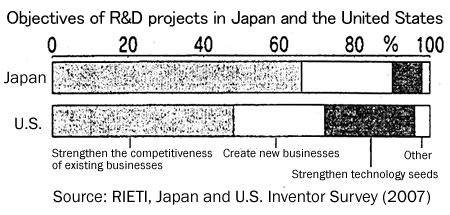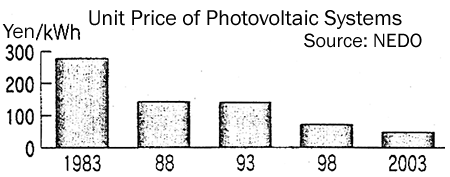Help industry to restructure R&D portfolio and sustain R&D investment for long-term needs such as for overcoming environmental and resource constraints
The role of innovation is attracting attention as a means of overcoming the current global recession. As part of his Administration's economic policy package, U.S. President Barack Obama has announced the Green New Deal program to invest in the development of environmentally friendly energy programs. The Obama Administration seeks to invest $150 billion (¥15 trillion) over the next decade in areas such as the development of next-generation bio-fuels and related infrastructure, plug-in hybrid cars that can be recharged at home, commercialization of renewable energy including solar power, and the creation of a grid systems that will collect electricity from widely dispersed small power producers.
The Obama Administration is also looking to move ahead on key initiatives that will increase the competitiveness of the United States. They include promoting trade policies for American companies to ensure they are fairly treated abroad, stepping up investment in science by doubling the federal government's basic research expenditures over the next decade, perpetuating preferential tax reduction based on R&D, expanding the competitive market by placing greater emphasis on the enforcement of antitrust laws, protecting intellectual property and reforming the patent system both in the U.S. and overseas, and using scientifically-sound evidence as the basis for government decision making.
Although the basic cause of the current recession is the bursting of the U.S. real estate and financial bubbles and the resulting breakdown of the working of the financial markets, it will be difficult to climb out of the recession through the implementation of financial measures alone, such as restructuring or writing off bad debt. Due to rapidly contracting demand resulting from the bursting of the bubble, production levels have declined very substantially so that they have now become a substantial obstacle to restoring the health of the financial system. Even though the degree of financial instability is said to be somewhat less severe in Japan, demand for capital goods and durable consumer goods - the mainstays of Japanese industry - is plunging as waves from the U.S. recession ripple across the world.
* * *
There are two critical factors Japan must consider in determining what innovation strategy it should adopt amid the global economic recession. First, Japan must seek to minimize the negative effect of the recession on its long-term economic growth rate. A significant decline in R&D investment due to financial constraints resulting from the recession would not only stifle effective demand in the short term, but would also decelerate the speed of creating and applying new knowledge. The overall result would be a lower long-term growth rate. The second factor is the acceleration of research activities on issues that the global economy is facing and must invariably solve over the long term, such as environmental and energy resource constraints. It is essential for Japan to use its R&D portfolio more effectively by taking advantage of the recession as an opportunity to dramatically reshuffle it. With respect to the first point, it is important to prevent the situation where companies scale back R&D investments due to their concern over risk despite having promising investment projects capable of generating positive long-term returns.
In this regard, what approach should corporate management take? According to the 2007 Inventor Survey that was conducted by the Research Institute of Economy, Trade and Industry (RIETI) to analyze the structural characteristics of R&D of Japanese companies and their challenges, slightly less than 70% of R&D projects were designed to strengthen the competitiveness of existing businesses, while approximately 25% sought to develop new businesses and about 10% looked to develop long-term technological seeds. In comparison with American companies, the R&D portfolio structure of Japanese companies may lean too far toward the reinforcement of existing businesses (Figure 1).

Demand for R&D that is closely related to existing businesses is expected to decline with the contraction in the market for products and services provided by existing businesses, which is attributable to the recession. It is therefore reasonable to reallocate resources such as R&D, which have been freed from immediate needs in these business areas, to the development of promising new long-term businesses and seeds. The survey indicates that the room for these initiatives exists and will enable Japanese companies to achieve higher growth after the recession. The same is also true for initiatives at the government level.
The survey also shows that even at large companies with 501 employees or more, 11% of R&D projects were constrained financially by the lack of risk taking capital so that the scope of R&D was downsized or the commencement or completion of projects was delayed in a more typical economic conditions. This ratio rises significantly, to 26%, at small companies with 100 employees or less.
From a management perspective, the issue of how skillfully R&D strategies can be executed during difficult economic times has a major impact on subsequent growth. However, given the relative risk averseness of banks and the capital markets today, because of the recession it is more likely that R&D investment will be constrained by a lack of risk-bearing capital. In this regard, the government should play a significant role. More specifically, it is important to complement private finance by using debt guarantees and the public venture capital of credit guarantee corporations, for example, to protect long-term research investments such as the development of new businesses and seeds for the future. In particular, it is essential to give due consideration to start-up companies.
* * *
To avoid sacrificing long-term growth during the course of the recession, in addition to the measures mentioned above it will also be necessary to accelerate R&D spending to confront long-term global economic issues. In this regard, the promotional role of the government for such investments will be consistent with the macroeconomic policy requirement to stimulate investments given that the room for monetary easing through lower interest rate is limited in Japan. To achieve long-term growth under the environmental constraints due to the use of fossil fuels, it is essential to develop technologies that will facilitate the use of sustainable energy resources, such as solar power and biomass, while increasing the efficiency in using fossil fuels through resource and energy conservation measures.
Technological advances have profound long-term benefits. In the case of photovoltaic power generation, the unit price per kilowatt hour in 2003 is approximately one-quarter what it was in 1983 (Figure 2). Significant contributions have been made by corporate R&D investments, government R&D grants (New Energy and Industrial Technology Development Organization), and improved economies of scale in production associated with the increasing use of technology; nevertheless, still significant technological progress is still needed before solar power becomes as competitive as existing electric power generation sources.

To effectively promote innovation in response to environmental and energy resource constraints, further advances must be made. First, it is necessary to create incentives that will encourage technological advances in the area of reduced carbon emission. The speed and direction of technological advances are very much driven by demand for technology. The high level of energy-saving technologies in Japan is strongly linked to its high domestic energy prices. The development of technologies capable of achieving meaningful savings in carbon emissions will require, among other measures, a full-scale implementation of an emissions-trading system. Through incentives such as these, development of new energy and R&D initiatives in the areas of energy conservation and de-carbonization will be stimulated.
Second, support for fundamental R&D needs to be enhanced. For environmentally friendly alternative energy sources such as photovoltaic power generation to gain a foothold and become competitive against electric power generated from fossil fuels, significant breakthroughs are still needed.
Third, in the area of fundamentally new technologies with room for significant cumulative development, support for the initial diffusion of these technologies could play an important role, and measures such as standardization will contribute to establishing the initial demand for kicking off the cumulative development process. Although their primary objective was not aimed at commercial use, military research and procurement in the U.S. played a significant role in the development of many fundamentally new technologies, such as a mass production system focused on compatibility, atomic energy, computers, the Internet, and the global positioning system (GPS). This suggests that government-generated initial demand for general-purpose technologies with wide multiplier effects on downstream technological advancement is extremely important for the creation of new technologies.
* * *
Finally, the global approach is also important. Environment and energy problems are global issues, and major countries around the world are stepping up their R&D initiatives to tackle them. Companies that have the ability to develop alternative energy are not always located in places where the alternative energy can be produced, therefore it is necessary from a global perspective to actively advance international cooperation in fundamental research areas while simultaneously to promote commercial research competition by emphasizing the intellectual property rights. The possibility for a firm to recover investment in technological development hinges on whether the global market for such technology exists, so that cultivating such market through international emissions trading and other means is also of critical importance.
* Translated by RIETI.
March 19, 2009 Nihon Keizai Shimbun


